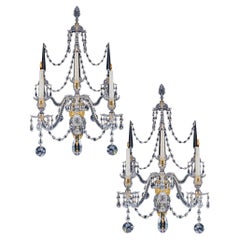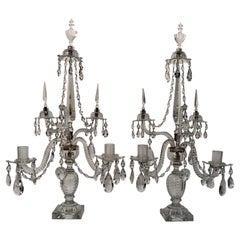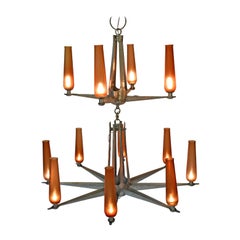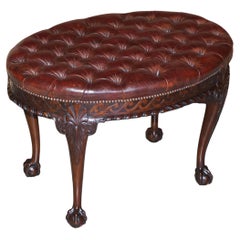We are delighted to offer this exquisite F Parker & Sons LTD circa 1900 fully stamped Mahogany framed , Claw & Ball feet bench stool with hand dyed Chesterfield brown leather upholstery circa 1900
A very decorative and expertly crafted piece, the timber cuts are exquisite and expertly carved, the Chesterfield tufted leather is hand dyed and has a wonderful antique patina throughout
This is a tall bench stool, I have seen them used as coffee tables with a glass top, in a bay window or as a piano stool, it is higher and larger than normal so ideally suited for tall people. The piece has the serial number stamped on the base rail and the furniture stamp inside the frame, we have fitted a new base cover so they are covered up but if you want to remove it, there are there
We have cleaned waxed and polished it from top to bottom, there will be age and use related patina marks here and there as you would expect from a piece this age
Dimensions
Height:- 60cm
Width:- 90cm
Depth:- 62cm
Please note all measurements are taken at the widest point,
Parker, Frederick; Frederick Parker & Sons;
London & High Wycombe; upholsterers, chair makers and furniture makers (fl.1869-2000)
Frederick Parker (b.1845-d.1927) was the son of William Parker, cabinet maker (b.c.1810-d.1897). He was apprenticed in 1862 to an upholsterer, George Davis, at 10 Clifton Street Finsbury, London. In 1869 Frederick set up in business as an upholsterer in lofts above the stables behind his father’s home and factory in Bracklyn Street, Hoxton. He bought in the chair and settee frames and strove to make a better quality product instead of the cheap goods prevalent in the area. Frederick was also a draughtsman and inventor; one of his specialities was the Box Ottoman, for which he invented and patented a special hinge, which allowed the top to be raised from either the left or the right side. These sold for £3 at factory prices and this product, known as the Ambidexter couch, won a Gold Medal for Parker at the 1884 Inventors’ Exhibition at Crystal Palace. As the enterprise grew he employed several men and boys; at this time frames were still bought in. Parker moved to Blomfield Street in 1871 and then moved to Wenlock Street where he lived and had workshops at the rear. He purchased a new home for his growing famil at Welton Villa, St Anne’s Road, Tottenham, in 1879, and in 1880 the firm moved to Curtain Road. Parker Bros were recorded at 104 to 108 Curtain Road in the Furniture Gazette, 1886. Here there were extensive workshops, a basement used as a chair-makers’ shop, and a front shop window. Frederick’s brother, Walter, also an upholsterer, and an accountant named Smith came into business with him, but the partnership of Parker, Smith & Parker only lasted 6 or 7 years (Parker, Smith & Parker listed at 117 Curtain Road in 1886). Afterwards Walter and his sons continued at Curtain Road and eventually took premises in Southgate Road, London, while in 1889 Frederick, having borrowed money from his father-in-law, took premises including a shop in Drummond Street, Hampstead Road. The chairmakers and upholsterers were paid 9d per hour, with the polisher at a rate of 8d per hour, and the hours were 9 ½ hours a day plus 6 ½ hours on Saturdays with holidays unpaid. The first major customers were Maples, Shoolbreds, Army & Navy Stores, Marshall & Snellgrove and Oetzmanns, with Liberty & Sons later.
During the 1890s the firm continued to make high quality seat furniture which was considerably more expensive than some rivals. About 1894 Parker moved to 280 Euston Road, a property owned by Shoolbreds. This building comprised two floors; one for the chairmakers, timber store and showroom and the floor above for upholsterers. A limited cabinet furniture production was also begun. However, shortly afterwards Shoolbreds decided to pull down the factory, so Parker transferred first to 44a Whitfield Street in 1895 and then to Charlotte Street (store and showroom) with a frame making workshop at Ockenden Road, Islington, before moving to High Wycombe in 1897. This last move was possibly encouraged by Alan Janes of the town who had been supplying the firm with chair frames for some years.
According to a surviving transcript of a talk given to new staff by Frederick’s son, Tom: ‘Dickson, an upholsterer and myself were the first to arrive with a van load of equipment. Later a few of our London frame makers joined up. Local workmen were available and soon joined us bringing their own candles – supplying their own light as was then the normal practice. Wages were slightly below London rates, business was good and it soon became necessary to provide extra space and so… a factory was built…’. Despite opinion from the established Wycombe makers that only the staple ‘Windsor’ and fancy chairs could be made in the town, the local Parker employees were trained by Mr Hill, the foreman, and were soon producing high quality upholstered seat furniture. The firm was the first in the area to do so. Hill continued to work for the firm until his death in 1904. About 1900 the existing sheds in Frogmoor, Wycombe, were replaced with three-storey buildings around a central timber yard and new machinery was installed. In 1901 a private limited company was formed with the title of Frederick Parker and Sons Ltd. Harry, William and Thomas (Tom) Parker all became directors and shares were also allocated to Kit Morris (a lady in the office), the two foremen (Messrs. Hill and Vincent), and the salesman, Mr Springett. Frederick Parker as chairman retained a controlling interest.
In 1902 Frederick purchased 20 Newman Street, London, as a showroom, and in 1904 he moved his home from Frogmoor to a large house (Cowley Peachey House or Clock House as it was known by the family) in Hayes, midway between Wycombe and London. Harry continued to live in Wycombe and he was responsible for running the factory while Tom joined his brother William working at Newman Street, where they shared responsibility for sales. A second factory was built on land acquired at the same time as the house at Cowley Peachey, near Uxbridge, adjacent to the Grand Union Canal, and to help in the company’s extensive trade in Europe a factory was taken at 183 Orenstrasse, Berlin. Meanwhile turnover increased from £13,095 in 1902 to £46,963 in 1912, and profits increased from £3,223 to £15,741 in those years.
About 1907-1910 Lucien R. Ercolani, a freelance designer, joined the firm. He recalled that the factory was ‘dark, untidy and disorderly’ but the craftsmen were making ‘jewellery of furniture’. Walter Ferry was also employed as a designer for the company in the early years of the 20th century. For a short period from 1900 Albert Barnes (fl.1900-37) worked for F. Parker and Sons Ltd as foreman woodcarver before joining W. Bartlett and then Goodearl Brothers in 1903. Barnes, who had known the Parkers in London, remembered them as ‘very fine people and cultured folk’ and Frederick was ‘a great man for truth and tradition’. In 1912 an upholsterer called Brinkman was sent to the Berlin factory and with William Kowers, a German in the textile trade, he built up the business there. This ceased with the outbreak of war in 1914. In 1912, in order to improve transport between the factories at Wycombe and Cowley with Newman Street, the company bought its first motor van. In 1913 the firm was hit by the Wycombe furniture makers’ strike, and in an attempt to break the dispute, Parker sent an agent to France to recruit carvers from Paris. He duly hired ten but at the rail station in Paris the Paris Wood Carvers’ Association representative intervened, telling the men the true reason for their recruitment, upon which news the men attacked Parker’s agent, who ended up in a Paris jail for causing a breach of the peace.
In 1920 the High Wycombe factories moved to Temple End. Frederick Parker retired in 1922, aged 76, leaving the business in the hands of his sons, Harry (who became Chairman), William and Tom. Frederick died in 1927. For a number of years until 1930, Frederick Parker & Sons had also acted as antique dealers, operating from their Newman Street showrooms, and Parkers, as it was often known, had a great reputation for their high quality reproduction furniture, which was all made to order. However, it was generally unknown to the public because most of the retailers put their own labels on the furniture supplied by the firm. Through Ambrose Heal, about 1928/29 Tom Parker met Willi Knoll from Stuttgart, who was trying to licence or sell his revolutionary seating system of laterally sprung ‘tension suspension’, and in 1931 at the British Industries Fair the new brand of Parker Knoll was launched. These new chairs were slow to appeal to the public but with advertising by the company and the fixing of a standard retail price to be used by all stockists, trade picked up. In the 1930s the firm could offer an amazing range of some 5,600 upholstery models and 2,500 cabinet pieces. Major commissions in the first part of the 20th century included 80 Chippendale-style chairs for the P & O liner Ophir, when it was commissioned as the Royal Yacht for the Prince and Princess of Wales’s first royal tour of the Dominions in 1902; cabinet work and upholstery for Sir Edwin Lutyens’ Viceroy’s House in New Delhi and the carved throne for Emperor Haile Selassie of Abyssinia. Early in 1914 Frederick Parker & Sons had begun manufacturing furniture for the Cunard Liner company; for the Aquitania over 200 Hepplewhite style chairs were supplied for the Second Class Dining Salon and a wide range of styles for the Palladian Lounge, some directly reproduced from the antique chair collection. The firm also furnished the liner Queen Mary and the aircraft designer Thomas Sopwith’s yacht, Endeavour, in 1935. In 1934
Parker Knoll chairs...







